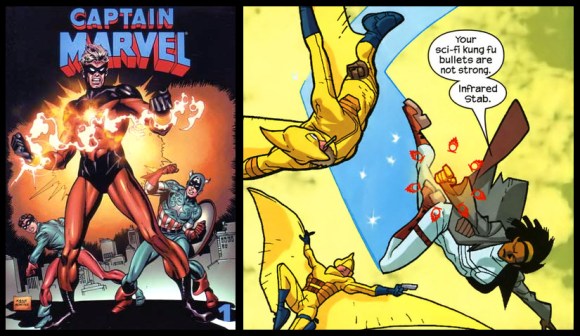Agent of S.T.Y.L.E. – Marvel’s Many Captain Marvels!
Agent of S.T.Y.L.E.
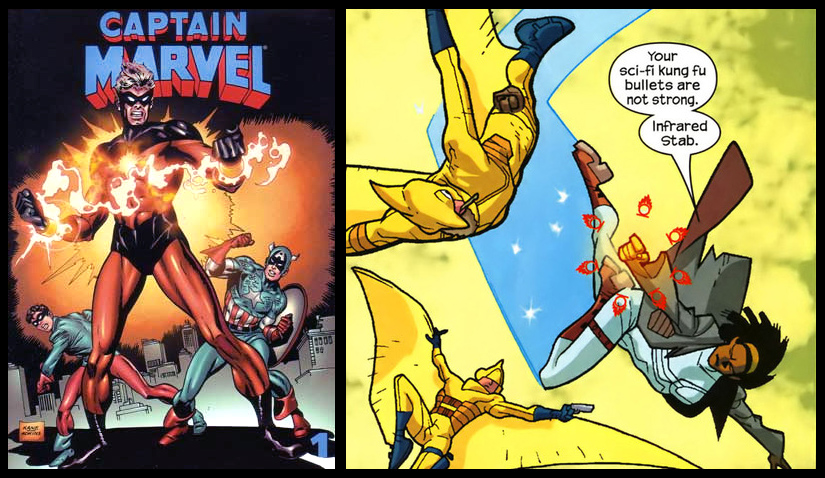
Last week, we talked about Billy Batson, the original Captain Marvel AKA Captain Thunder AKA Shazam. He was created by Fawcett Comics and is now owned by DC Comics. But this time around, we’re talking about the heroes who have used that name over in the Marvel Comics Universe.
The first Captain Marvel’s original run of adventures, and Fawcett Comics, ended in 1954. In 1961, the company which had originally been called Timely Publications, and was known during the 50s’ as Atlas, rebranded itself as Marvel Comics, referencing the title of the first series the company published in 1939. That same year saw the publication of Fantastic Four #1, which was the true start of the Marvel Universe as we know it. Six years later, Marvel trademarked the comic book title “Captain Marvel” since no one else was using it at the time. Now all they needed was a character to use the name.
A MAN NAMED MAR-VELL
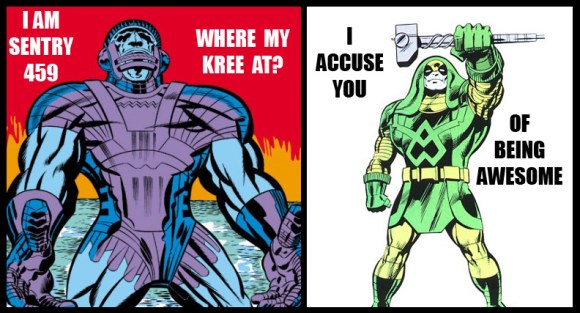
That’s what happens when it’s late at night and I’m on photoshop. I add captions to comic book images and giggle at it. I’d feel weird about it, but then I remember that Tumblr exists.
Anyway, before we met the Marvel Comics version of Captain Marvel, we met his people. In 1967, Fantastic Four #64 showed the heroic team of explorers defeat a powerful robot known as Kree Sentry #469. The robot was an advance scout of the Kree Empire, which then appeared the very next issue and sent Ronan the Accuser after the Fantastic Four (the role of Accuser is like soldier and judge combined). The Kree came from the planet Hala and their empire spanned many planets, with the world Kree-Lar acting as its capital. The Kree Empire was ruled by a living computer called the Supreme Intelligence, a creepy green head with tentacle hair whose programming was formed by the downloaded minds of the society’s greatest military leaders, scientists and philosophers who had died.
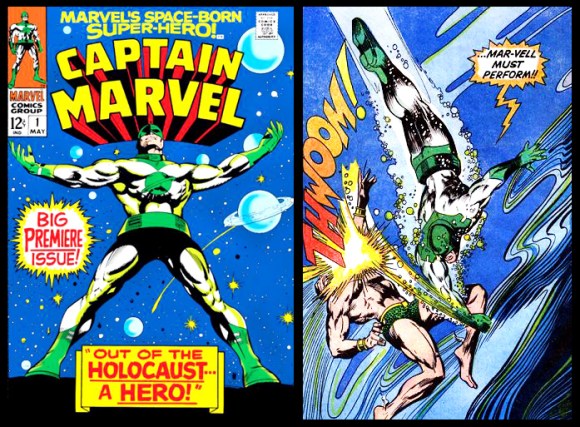
Starting in 1966, Marvel Super-Heroes was an anthology series that reprinted old stories. But a couple of months after the FF met the Kree and defeated the Sentry and Ronan, Marvel Super-Heroes featured original stories for four issues. Issues #12 and 13 debuted a Kree soldier named Mar-Vell, part of an infiltration team led by Colonel Yon-Rogg to gather intel on Earth. He adopted the alias of “C. Marvel” (definitely a better soldier than he is a spy, thinking that one up) and then took the identity of scientist Walter Lawson so he could infiltrate a military base. There, he met USAF Major Carol Danvers, head of security. We talked about her recently too, remember?
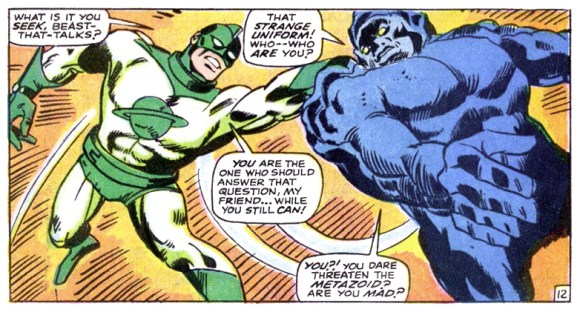
Meanwhile, Yon-Rogg planned Mar-Vell’s death, jealous of how medical officer Una loved him. Rogg remotely re-activated Sentry 495 and it attacked the base. Since this endangered his mission to learn more about Earth’s military and technological strengths, Mar-Vell put on his Kree uniform and went off to stop the robot. Along with his Kree strength, the advanced tech of Mar-Vell’s uniform provided flight and a variety of weapons. The story continued in the new series Captain Marvel. In the first issue, soldiers who heard the protagonist’s name and thought his uniform was a costume concluded that this was a new superhero named Captain Marvel rather than an alien military officer. Mar-Vell played along and Carol Danvers became romantically interested in this mysterious hero, not knowing he was in love with Una.
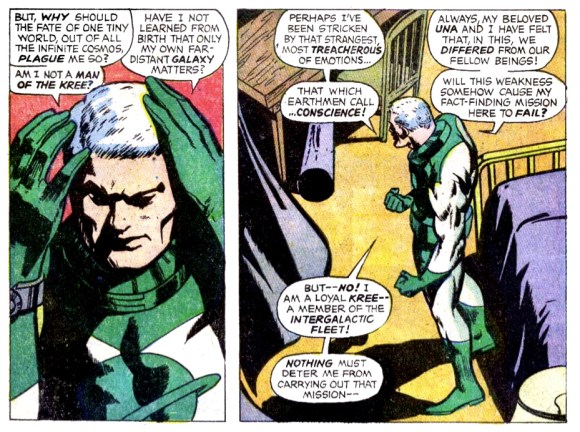
Over time, Mar-Vell wrestled with his conscience about the ethics of his mission and the goodness he saw in the people of Earth. When Yon-Rogg attempted to test methods of germ warfare on the human race, Mar-Vell stopped him. Soon enough, the captain really was a superhero, protecting Earth from the empire he came to see as corrupt and dangerous. Despite his new loyalties, Mar-Vell kept wearing his uniform which just didn’t make much sense. The design is a pretty generic 1960’s idea of what an alien soldier or future soldier might look like. The only things that stand out are the finned helmet and the ringed planet on the shirt.

These touches aren’t bad, and its nice that the helmet immediately implies warrior, but the design loses a lot when you see other Kree soldiers dressed in near-identical uniforms, their ranks signified by the color and what celestial body is on their chest. The Green Lanterns get away with all dressing the same because they’re all fighting for the same cause and they have one very cool symbol that works for them. Mar-Vell no longer really served the Kree Empire and if you didn’t know about the ranks, you might think just felt like advertising that he was from some ringed planet.
About a year after his debut, it was clear the hero wasn’t striking a chord with readers so Marvel decided to shake up his status quo. In Captain Marvel #11, Mar-Vell’s love Una was killed during a battle, giving us the all-too familiar trope where a woman’s death gives the hero proper angst and man-pain so he’s driven to fight evil even though he was doing it anyway. In the same issue, Mar-Vell was contacted by a god-like being named Zo who said he had great plans for the hero. Zo got rid of Mar-Vell’s tech and gave him actual super-powers, including flight, illusion casting and the ability to teleport anywhere in the universe.
Gotta say, flight AND teleportation seems greedy. Choose one superhuman mode of transport, buddy.
Arnold Drake wrote issues #11-12, but then left and writer Gary Friedrich continued the storyline in issues #13-15. Surprisingly, this new status quo was thrown out the window in issue #16 (1969), written by Archie Goodwin, in which Mar-Vell was brought before the Supreme Intelligence. The big giant green head told our hero, “Yo, brother, there isn’t any god or cosmic being named Zo. Did you not realize that Zo is just Oz spelled backwards and this is just another guy pretending to be all-powerful? It was all illusions created by outlawed Kree science operated by Ronan and Imperial Minister Zarek, who were using you as part of their plan to take over the government. Basically, the past five issues leading up to this moment were a big lie, done for the sake of a needlessly convoluted plan that you shouldn’t question. Your powers are real, though. Zarek gave them to you with experimental science because, you know, science.”
(Ok, the Supreme Intelligence didn’t say it just like that, but roll with me on this.)
HERO OF THE STARS
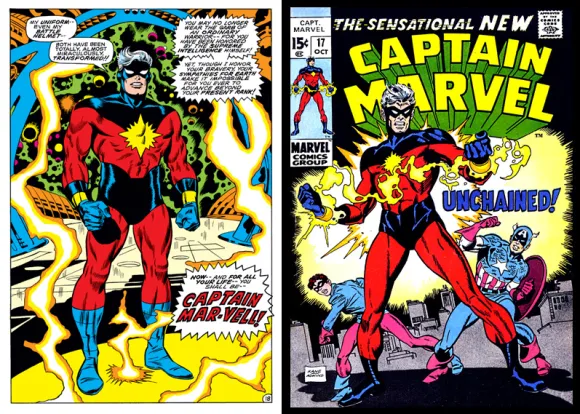
Following the Supreme Intelligence’s revelations, Zarek and Ronan immediately attempted destroying the living computer with a special bomb and Mar-Vell risked his life to stop it. The Supreme Intelligence honored the hero with a unique costume that made him stand apart from other Kree, while also telling him that his sympathy for Earth meant he would never rise above the rank of Captain. So in issue #16, we got what is now considered the classic costume of Captain Mar-Vell, drawn by Don Heck. It’s pretty great, too! The previous shirt design seemed to indicate a particular planet and then became less special when you learned it just signified a rank. Replacing it with a star gave a stronger impression that Mar-Vell was a champion of the cosmos and not just one alien world. The black and red are a stronger color combination and all of a sudden he really does look more like a superhero rather than a Flash Gordon villain. The only odd thing is the yellow bands around his wrists. They weren’t gold bracelets, the were just yellow fabric decorating the black gloves. The bracelets didn’t come until the next issue.
Happy with his new threads, Mar-Vell left the Supremor and flew off, only to be suddenly hurled into that anti-matter reality known to Marvel superheroes as the Negative Zone. Apparently, this was due to radiation he’d absorbed from the bomb Zarek and Ronan had used. In Captain Marvel #17, written by Roy Thomas, Mar-Vell transmitted mental images to Rick Jones, a teenager who’d originally been the Hulk’s buddy, helped form the Avengers, and then served as Captain America’s partner for a while. Guided by Mar-Vell, Rick went into a cave that housed a secret Kree outpost abandoned years ago. Among the alien technology were the powerful and unique “Nega-Bands.” Mar-Vell asked Rick to put on the golden bracelets and slam then together. Trusting the strange ghost-like being he’d never met before, Rick did as he was told.
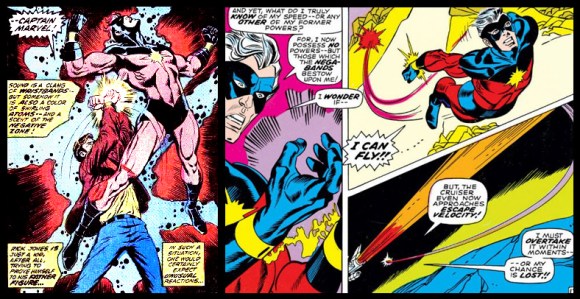
The bracelets made a loud metallic “KTANG!” and a flash of energy exchanged Rick’s atoms with Mar-Vell’s, sending the kid into the Negative Zone while Marvel now stood on Earth, the Nega-Bands on his wrists. Strangely, Mar-Vell lost his super-powers as a result of this affair, but then learned that the Nega-Bands gave him cool powers anyway, granting increased strength and protection, energy manipulation, and faster than light flight. Mar-Vell could only remain in Earth’s dimension for three hours until his health was endangered, at which point he’d have to switch with Rick again and recover for a while in the Negative Zone. So starting with issue #17, this became the new status quo. Rick would summon Captain Mar-Vell whenever there was evil to fight and the two were in constant telepathic contact.
Now, I’m sure some of you noticed that this Roy Thomas alteration sounds similar to how Billy Batson would say “Shazam” and transform into the adult Captain Marvel. Roy Thomas, as we discussed last week, was very interested in rebooting that particular superhero and this was his first attempt, replacing the magical thunderbolt and magic word with alien science and a sound effect.
Although this wasn’t a bad idea, it still didn’t really strike a chord with readers and many had been turned off by the fact that Mar-Vell’s status quo had been reimagined three times within a year (issues #11, 16 and 17). After five more issues, Captain Marvel ended with #21 in the summer of 1970. The hero appeared in a couple of other comics and then had his life changed again in 1971, in Avengers #89. Written by Roy Thomas, this issue was the beginning of the Kree-Skrull War storyline and revealed that Mar-Vell and Rick Jones were no longer bonded. A flashback explained how this happened, but it really didn’t matter. At the end of the storyline, Rick was critically injured and Vell bonded with him again to save his life.
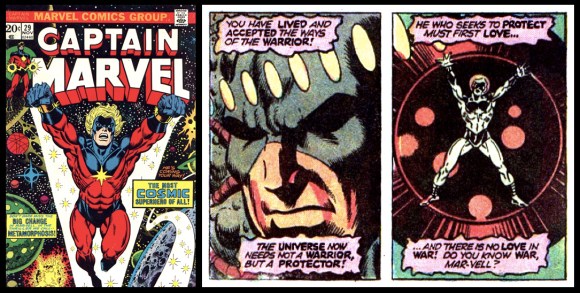
The same year Mar-Vell’s series ended, DC Comics started publishing the original version of Captain Marvel again. Copyright can last for years, but trademarks need to constantly be renewed. So to ensure that only Marvel Comics could publish a title called “Captain Marvel” and DC didn’t steal it back, Mar-Vell’s solo series resumed as a bi-monthly release in 1972. Writer Jim Starlin changed the atmosphere of the stories with issue #29 in 1973. The story “Metamorphosis” introduced the cosmic entity Eon, who chose Captain Mar-Vell to act as a literal protector of the universe. Along with cosmic awareness and new insights into his own life, Vell’s white/silver hair now became blonde, which I think works rather nicely with him and his costume colors.
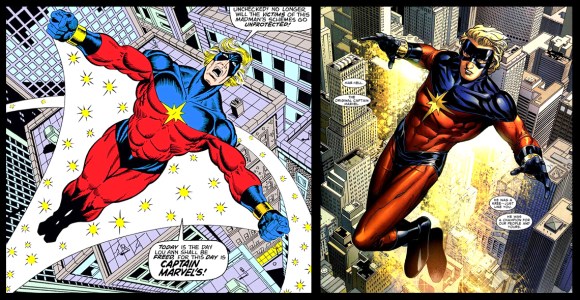
Another change was that the hero now utilized solar and stellar radiation as a major source of energy, resulting in a glowing star field trail whenever he flew through the air. Mar-Vell called this “photonic energy exhaust.” It’s a great visual, especially with today’s artistic techniques. It marks Mar-Vell as a cosmic angel. Starlin’s changes and Mar-Vell’s new cosmic odyssey gained a loyal fan following. But sales still weren’t stellar and Starlin left the book.
In issue #50 (1977), Mar-Vell fight alongside the Avengers against the Super-Adaptoid, an android that copied super-powers and weapons. Mar-Vell tricked the Super-Adaptoid into replicating the Nega-Bands, then slammed the replicas together. The android was sent into the Negative Zone and traded places with Rick. Now, the teenager and the superhero were both on Earth and free to live separate lives. The new status quo failed to generate interest though, and Mar-Vell’s series ended in 1979 with issue #62, just a year after Carol Danvers became Ms. Marvel. He starred in the first four issues of the series Marvel Spotlight before passing away in the 1980 graphic novel The Death of Captain Marvel. Written by Jim Starlin, the story had Mar-Vell reveal to his friends that he had contracted cancer due to exposure to poisonous gasses during a battle with the villain Nitro in Captain Marvel #34 (1974).
Since the 1990s, a few writers at Marvel have retroactively made Mar-Vell a much more revered figure among the other superheroes. Characters have spoken about him with as an inspiration, the soldier who became a man of peace and turned away from his own world because he couldn’t ignore his conscience. It’s given him a status similar to Superman back in the old days of DC, making his death all the more tragic.
MONICA OF MANY NAMES
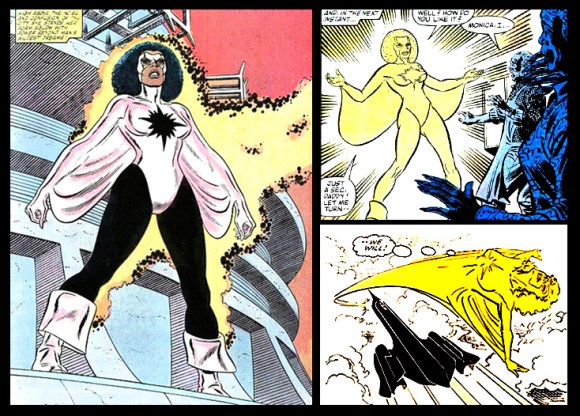
Mar-Vell was dead, but Marvel Comics wanted to make sure they kept the “Captain Marvel” trademark. So in 1982, in the pages of Amazing Spider-Man Annual #16, readers met Lt. Monica Rambeau of the New Orleans Harbor Patrol. Created by writer Roger Stern and artist John Romita Sr., this new Captain Marvel wasn’t just a lady but an African-American. Quite the difference from the blond-haired, blue-eyed caucasian alien. Romita had wanted to model her on Pam Grier, but was told to tone this down and base it more on another model deemed more attractive. In her debut story, Monica interrupted some baddies working on an experimental weapon. As a result, her body was exposed to strange, extra-dimensional energies. Mar-Vell had been able to absorb solar radiation and convert its energy into super-powers, but Monica could now turn her whole body into energy and absorb just about any kind of radiation. Donning some costume pieces she found in a storage room, she embarked on a career as the new Captain Marvel.

This costume is pretty fun. By today’s standards, many of us would find it silly, but we’ve got to remember to enter the mindset of the 1980s. This says superhero with a hint of rock star. I’m not entire sure about that cape attached to the arms. Monica often flew by becoming light and shooting off like a ray, so you don’t get to see the cape really move in the wind or anything. It doesn’t bother me, just seems a bit unnecessary. By the way, a pal of Monica’s later got her an identical outfit that was made from unstable molecule fabric, the material created by Reed Richards of the Fantastic Four that is just about indestructible and interacts with super-powers.
Monica made regular appearances in Avengers, joining the team and serving admirably. Though she had no connection to their fallen ally, the Avengers welcomed her and concluded that her professional attitude and heroic spirit were more than enough to justify her using the name Captain Marvel. Monica made some personal enemies of her own, including a space pirate named Nebula who will appear in this summer’s movie Guardians of the Galaxy, portrayed by Karen Gillan.
Monica was bad-ass enough that in 1987, she actually became leader of the Avengers for a while. But a year later, Marvel started thinking that things should change and that Monica was no longer needed in the Avengers comic. Rather than having her leave the group for personal reasons, she accidentally lost control of her powers and form during a battle. In Avengers #293, she regained her physical form, but at the cost of her health and super-powers. She retired from the team and superheroics in the next issue and Marvel apparently lost one of its only African-American superhero women.
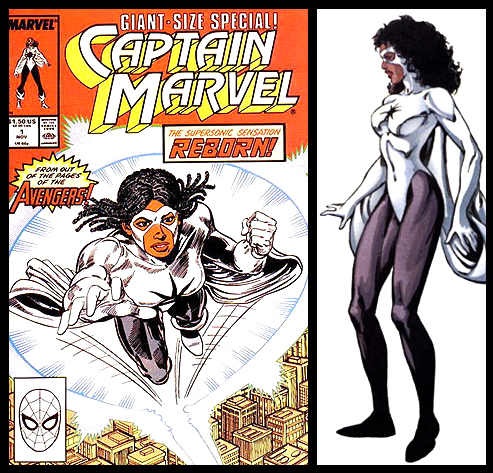
In 1989, writer Dwayne McDuffie brought Monica back into play in her own self-titled “giant-size special.” If you don’t know Dwayne McDuffie’s work, he was a huge player behind the Justice League and Justice League Unlimited cartoons, and one of the creators of the character Static. He did a lot to increase and call attention to diversity in superhero comics. In her one-shot special, Monica got her health back, along with altered abilities. She didn’t get her own series, but she did get to be a recurring character in Avengers stories, acting as a reservist and stand-in leader at times. Her original powers came back full force in 1994, during an adventure she had in the series Quasar, starring a hero who became a visual and spiritual successor to Mar-Vell in a few ways.
The next year though, a new Captain Marvel appeared: Genis-Vell, son of Mar-Vell. Though Genis had no problem with Monica using the name Captain Marvel, she conceded the title to him since it had been used by his father first, and more and more people were calling him by it anyway. I can’t help but think about what it means that Monica never got her own series, despite her popularity and years as a hero, yet Captain Mar-Vell’s son got one almost immediately and was given his dad’s code name even though it was already being used. Food for thought there.
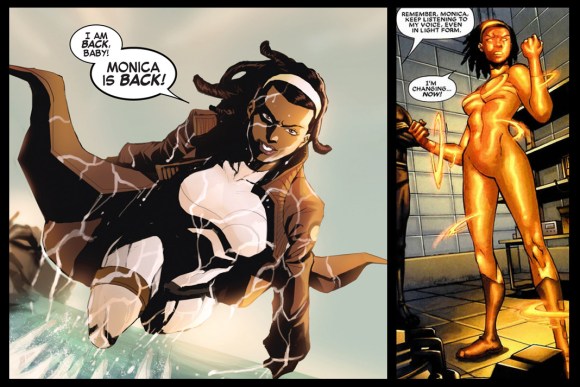
For the next several years, Monica kept her old costume but used the new name Photon. Then when Genis-Vell wound up adopting the name Photon, Monica decided to call herself Pulsar instead (the lady has no right to her own codename?). Then Genis-Vell was gone and Monica went back to Photon. Along the way, she also got herself a new white jumpsuit and trench coat look that she first wore in the series Nextwave. This series was originally supposed to take place outside of Marvel Comics canon, but it wound up getting absorbed into the mainstream continuity. Not a lot to the outfit, but I dig the trench coat and Monica was awesome in the series.
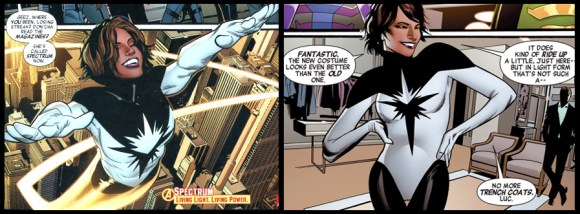
Recently, Monica joined the cast of Mighty Avengers, rocking a new costume, haircut and codename: Spectrum. I miss and prefer the old hair, but this new costume is great. A really nice update of her original look that also has a nice twist on the star design. Well done.
We’re going to end this for now. Next week, we’ll conclude this discussion of the Captain Marvel legacy as we take a look at Genis-Vell, his sister Phyla-Vell, Noh-Var, Carol Danvers, and a certain confused Skrull. Send us your suggestions for other characters you want covered. Until next time, this is Alan Kistler, Agent of S.T.Y.L.E., signing off!
Alan Sizzler Kistler is an actor and author who identifies as a feminist, knows way too much about fictional planets, and may have written a screenplay for Mar-Vell and Carol Danvers in his spare time. He is the author of Doctor Who: A History.
Have a tip we should know? [email protected]
